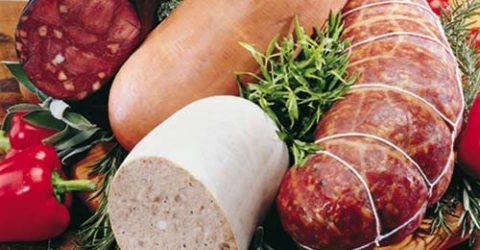Beef bung, also known as beef middle or beef round, refers to a specific part of the cow’s intestine that is commonly used as a sausage casing. Although it may sound unappetizing at first, beef bung has been used for centuries to make sausages and other encased meat products. In this complete guide, we’ll demystify the beef bung by explaining exactly what it is, how it’s used, and why it produces such distinctive sausages.
What is Beef Bung?
Beef bung is part of the cow’s intestine obtained during slaughter. Specifically, it is the end of the large intestine where digested food enters just before exiting the body as waste. The beef bung is the largest part of the intestine, with a diameter between 38-62mm. Its tubular shape makes it well-suited for encasing ground meats into sausages and deli meats.
During processing, the inner mucosa lining and outer fat layers are thoroughly cleaned from the beef bung, leaving just the muscular middle layer known as the submucosa. This collagen-rich submucosa layer gives the casing strength, flexibility and permeability for use in sausage production. Once cleaned, the bung is flushed, salted, sorted by size and quality, measured into units, and packaged for distribution to meat processors.
Key Properties of Beef Bung Casings
There are several beneficial properties that make beef bung an excellent choice for certain sausage applications
- Large diameter – The beef bung has the largest diameter of any cattle casing, making it well-suited for salami, bologna, mortadella, braunschweiger, and other large sausage products.
- Uniform shape – Unlike small intestine casings, beef bung maintains a uniform tubular shape without curves or narrowing. This gives the encased sausage a consistent thickness and straight shape.
- Traditional appearance – Sausages encased in beef bung have a classic old-world look that is associated with artisanal products like salami.
- Permeability – Beef bung allows smoke, moisture and seasoning to penetrate during processing while keeping the filling contained.
- Strength – Its collagen-rich structure gives beef bung strength to withstand stuffing and smoking without tearing.
- Edibility – Since beef bung is part of the cow’s natural intestine, it is edible and does not need to be removed before eating the sausage.
How is Beef Bung Used to Make Sausage?
Using beef bung to make sausage involves a few key steps:
- Soaking – First, the beef bung casing must be soaked in water to rehydrate it and make it pliable for stuffing. Soaking in a phosphate and salt solution can further soften the casing and improve the finished texture.
- Stuffing – Next, the casing is loaded onto the stuffing horn of a sausage stuffer, which pumps the ground and seasoned meat mixture into the casing. Beef bung is often stuffed using large-scale automated equipment.
- Clipping – Once stuffed, the open end of the filled casing is clipped closed with a metal clipper to seal in the meat.
- Cooking – The encased sausage then undergoes a thermal processing schedule involving stages of drying, smoking, and moist-heat cooking to reach the required internal temperature.
- Cooling and drying – After cooking, the sausage is cooled and may be further dried to finalize the texture and moisture content.
- Slicing and packaging – Finally, the sausage logs are portioned into slices or chunks and vacuum packaged for distribution and retail sale.
What Types of Sausages Use Beef Bung Casings?
The extra-large diameter and sturdy texture of beef bung make it ideal for:
- Salami – From Italian-style Genoa salami to Hungarian and German varieties, salami sausage uses beef bung to achieve the classic salami shape, size and texture.
- Bologna – Traditional ring bologna sausage depends on beef bung casing to create the distinctive ring shape and large diameter.
- Mortadella – This classic Italian deli meat gets its jumbo size and thickness from being stuffed into beef bung.
- Braunschweiger – Beef bung casing gives this soft, spreadable German liver sausage a smooth exterior that slices neatly.
- Blood sausage – Also known as black pudding, blood sausage uses beef bung as one of the few casings large enough to hold this delicate mixture.
- Head cheese – Versatile beef bladder, the largest cattle casing, is ideal for molding this jellied loaf made from head meat.
- Specialty sausages – Other large-diameter sausages like souse and Scottish haggis rely on beef bung casing as well.
So although it may not be the most elegant part of the cow, beef bung transforms some of the most iconic sausages into their classic and crave-worthy forms. Next time you slice into a ring of bologna or rich salami, you can appreciate the important role this humble beef intestine plays in creating your favorite deli meat masterpieces.

Capicola, step 3 beef bung casing
FAQ
What is meat bung?
What size is a beef bung?
What is cow bung?
How long to soak beef bung?
What are beef bung caps used for?
Firstly, beef bung caps. These are used for large sausages and come from the cow’s large intestine. You might find them useful for making mortadella, bologna (large), and souse sausages. Next, there are beef middles, which may be removed rather than eaten. These tend to be heavier casings, and they are often used for salami.
What is a beef bung casing?
Beef rounds have a ring shape and are very often used in the production of polish sausage and rim bologna. They also have a lower fat content than most other casings. Beef bung casings are made from the cow’s appendix. Bung caps are the largest of the natural casings. These casings are incredibly durable and never edible.
How big is a beef bung?
Beef bungs range in size from 4.5 to 5 inches in diameter and are approximately 18 inches in length. The following figure shows several different types of casings next to each other to give you context for the differences.
What are Bung casings made of?
Beef bung casings are made from the cow’s appendix. Bung caps are the largest of the natural casings. These casings are incredibly durable and never edible. Sheep casings are made from sheep intestines. They tend to be fragile and smaller in size than other casings, and they are the tenderest choice for casings.
